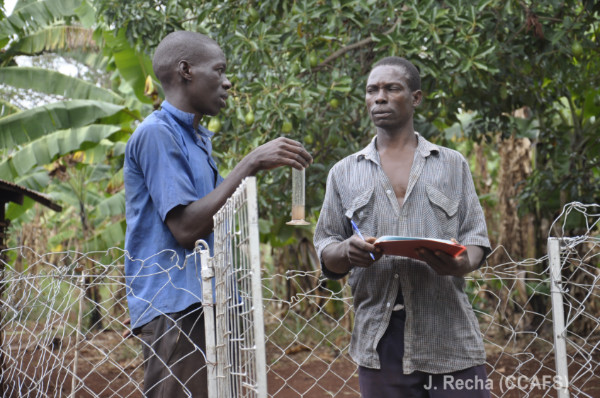
Informing biodiversity conservation strategies in Uganda and beyond

Context
Although forests provide several benefits on a global scale, the cost of conserving them falls disproportionately on local communities. As part of global climate change avoidance and mitigation negotiations, countries have committed to paying the parties who conserve forests and to reducing emissions. However, there is little evidence on which conservation and emissions reduction strategies are the most cost-effective in balancing conservation with socio-economic well-being.
The United Nations and the World Bank count payments for ecosystems services (PES) as an attractive option to promote sustainable development under ‘reducing emissions from deforestation and forest degradation’, known as REDD+. PES programmes provide forest users and private forest owners incentives to avoid activities that might deforest or degrade forests.
To provide evidence on the effectiveness and cost-effectiveness of PES, researchers affiliated with Innovations for Poverty Action evaluated a pilot PES programme in western Uganda. UNEP funded the pilot, under which enrolled private forest owners were required to conserve their entire forest and were prohibited from cutting down any medium-sized trees. They were paid extra for planting tree seedlings.
Starting in 2010, the researchers evaluated the pilot PES programme’s impacts on deforestation and livelihood outcomes of smallholder landowners in Hoima and Kibale districts. Uganda’s National Environment Management Authority and a local implementer, Chimpanzee Sanctuary and Wildlife Conservation Trust, were key collaborators on the pilot and its evaluation.
Evidence
Using high-resolution satellite images, the researchers found that the pilot PES programme led to a sharp reduction in deforestation. Between baseline and endline, tree cover on forest owners’ land declined by 2–5 per cent in villages whose enrolled private forest owners received US$28 per hectare of forest conserved, whereas it declined by 7–10 per cent in villages outside the programme area.
Participants were 14 per cent less likely to have cut any trees a year into the pilot programme. It averted a ton of CO2 emissions at an estimated cost of US$0.57.
The evaluation also found no evidence of tree-cutting shifting to areas outside the pilot.
Evidence impacts
Type of impact: Inform discussions of policies and programs
When subsequent phases of the evaluated programme or policy draw from the findings of the evaluation or review, and/or the study team participates in informing the design of a subsequent phase.
This is one of 3ie’s seven types of evidence use. Impact types are based on what we find in the monitoring data for an evaluation or review. Due to the nature of evidence-informed decision-making and action, 3ie looks for verifiable contributions that our evidence makes, not attribution.
Read our complete evidence impact typology and verification approach here.
Close windowUganda’s National Environment Management Authority, the Chimpanzee Sanctuary and Wildlife Conservation Trustand other conservation organisations built on the findings of the Hoima and Kibale pilot, amongst other projects, to review the proposed National Environmental Management Policy and contribute to discussions on drafting the new environment law. The National Environment Act of 2019 updates the previous law to include PES for conservation and management of biological diversity.
Type of impact: Inform the design of other programs
Where findings from the evaluation or review inform the design of a program(s) other than the one(s) evaluated.
This is one of 3ie’s seven types of evidence use. Impact types are based on what we find in the monitoring data for an evaluation or review. Due to the nature of evidence-informed decision-making and action, 3ie looks for verifiable contributions that our evidence makes, not attribution.
Read our complete evidence impact typology and verification approach here.
Close windowThe need for coordination during the evaluation prompted the formation of the Northern Albertine Rift Conservation Group, a loose network of conservation partners in the region, including the Chimpanzee Sanctuary and Wildlife Conservation Trust, ECOTRUST, World Conservation Society and the Jane Goodall Institute. The evaluation and its findings informed the design of the network’s 2014 project, funded by the UK-based Darwin Initiative, to provide livelihoods support and incentives to private forest owning communities in the region.
Type of impact: Inform global guidelines and policy discussions
When findings from an evaluation or review can be traced to discussions or actions. Examples include governments or multilateral or bilateral donors’ mentioning the findings to inform policy or programming. To date, we have only one case of an individual impact evaluation informing global health guidelines. WHO guidelines require that the guidance is based on randomised evaluation evidence.
This is one of 3ie’s seven types of evidence use. Impact types are based on what we find in the monitoring data for an evaluation or review. Due to the nature of evidence-informed decision-making and action, 3ie looks for verifiable contributions that our evidence makes, not attribution.
Read our complete evidence impact typology and verification approach here.
Close windowThe evaluation was featured in UNEP’s global study on trade in environmentally sound technologies. The study cites the evaluation as a resource to understand the effectiveness and limitations of PES as part of green industrial policies. The evaluation’s findings and design also informed a USAID document that compiles lessons for informing the regional PES guidelines for the Lake Victoria Basin Commission.
Suggested citation
International Initiative for Impact Evaluation (3ie), 2020. Informing biodiversity conservation strategies in Uganda and beyond [online summary], Evidence Impact Summaries. New Delhi: 3ie.
Related
Terminal evaluation of the project: developing experimental methodology to test PES effectiveness in conservation in Uganda
This 2015 UNEP-commissioned study analyses the pilot project, the evaluation and its impacts (Section 2.11.2).
Evidence impact summaries aim to demonstrate and encourage the use of evidence to inform programming and policymaking. These reflect the information available to 3ie at the time of posting. Since several factors influence policymaking, the summaries highlight contributions of evidence rather than endorsing a policy or decision or claiming that it can be attributed solely to evidence. If you have any suggestions or updates to improve this summary, please write to influence@3ieimpact.org